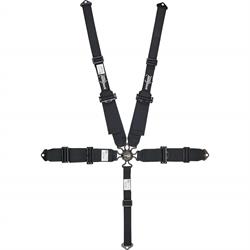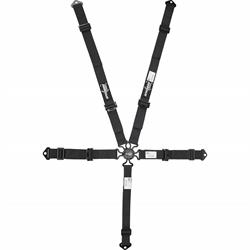How to Choose a Racing Harness
Importance of Racing Harnesses
Seat belts and racing harnesses are among the top five most important safety items you can buy for your race car. With all the options out there between size, length, closure type, and adjustability, it can be hard to decide on a specific set. This guide will give you helpful tips to look for in each belt, and help you narrow down your choices for an informed decision.
Do I need a 3-inch or 2-inch belt?
First off, let's look at size. The majority of belts come in a 3-inch width. They are common in bigger classes of cars such as sport compacts, hobby stocks, modifieds, and sprint cars. There are also a few belts that are 2 inches wide. These are common for smaller cars such as cage carts, quarter midgets, and junior sprints. You want to check your local track or series rules to see if they require a specific size.
From there, it comes down to what you race. The only exception to this is that some 3-inch harnesses have an option for 2-inch upper shoulder belts. These are referred to as ‘HANS’ type belts. When wearing a HANS device, these narrower belts fit the HANS shoulders better. Some belts you can upgrade the shoulder belt portions for HANS use versus buying all new belts. Check out this Toolbox article to learn more about HANS devices.
What Belt Length is Right for Me?
Next, let's discuss belt length and why you might need a longer belt. Some belts are made longer to facilitate attachment points that are not directly behind your seat. In some race cars, such as quarter midgets, the belts need to be longer to reach the bars they are attaching to. Harnesses can be bolt-in, wrap-around, or both. Bolt-in harnesses have a triangular bracket at the end of the belt that bolts through a spud or tab welded onto your frame. Usually, these brackets are sewn in place and are not removable. Wrap-around harnesses are just that; the belt wraps around a frame gusset and passes through a buckle multiple times to hold itself in place. A good option for this type of harness is Speedway's Racing Harness/Shoulder Pad/Sternum Protector Kit. Some belts offer a combination; a wrap-around end but include a bolt-in triangular bracket that the belt can be threaded through and secured into the harness using the wrap-around buckle. With the bracket, you basically turn the wrap-around belt into a bolt-in. See "How Do I Mount My Safety Harness?" section below for more details on proper mounting configurations and belt angles.
What is the Difference Between Latch-and-Link and Cam Lock Belts?
The next option on harnesses is the latch type, such as the Speedway Elite 5 Point Seat Belt Harness shown here. There are basically two different kinds of latches; latch-and-link and cam lock. The latch-and-link belts are the most popular and most common. They basically operate as a hook and loop. The shoulder belts and sub belt slide onto the loop, and the hook latches onto the loop, holding it all together. The cam lock latch operates as a hub. The shoulder belts, sub belt, and other lap belt push into the cam latch, clicking into place like a street car seat belt.
To release, you simply pull or rotate a lever or knob, which activates a cam-release inside the latch, releasing all the belts simultaneously. Generally, the cam lock belts are easy to operate, allowing the belts to be locked in/secured one at a time, but are more expensive. Whereas, the latch-and-link belts are nearly infallible, but take a little effort to get used to and don’t release quite as easily.
A close up of the latch-and-link style belt latch helps provide some clarity to the design. As you can see, the right lap belt has the link loop end sewn into it and the sub strap end buckle, along with both shoulder strap end buckles, slip over the link loop portion. Finally, the left lap belt's end buckle is slipped over the end of the link loop and the left belt's latch lever is pushed towards the belt webbing to engage the latch into the right lap belt's link loop, retaining all five belt segments.
In this detail image of a Simpson belt we have the cam lock style of latch. Similar to the latch-and-link, the belt starts with the main latch assembly as part of the right lap belt. However, that is pretty much where any similarity ends. The remaining belts, which include left and right shoulder, sub strap, and left lap belt, all have a latch "tongue" like a production car seatbelt that can be inserted into the cam lock latch individually. This makes belting in yourself a little easier. Then, instead of lifting the latch-and-link lever, you either twist or pull the cam lock lever to release all the belts at once.
To see the difference between latch-and-link and cam locking systems in action, we have a helpful short video
What Type of Belt Adjustment is Best?
The type of adjustability each belt has is another consideration. The basic types are pull-up, pull-down, and ratcheting. When a belt is a pull-up design, it means that the lap belts tighten by pulling the belt's "tail" upward toward the latch. These belts are easier for the driver to tighten himself. In comparison, a pull-down design means the belt tightens by pulling the belt's "tail" downward away from the latch. These are easier to have someone outside the vehicle tighten for the driver. Lastly, ratcheting seat belts have a mechanism on the left side lap belt that, once latched together, the ratchet can be tightened a lot tighter than simply pulling on the "tail".
They use a standard 1/4-inch ratchet and still utilize the standard latch-and-link style latch. Ratcheting belts, such as this Hooker Harness are most common in sprint cars and other race cars with enough clearance around the left side of the seat to mount and access the ratcheting mechanism. These require a bolt-in spud or extra frame bracket.
What is the Benefit of a 6-Point Restraint?
The one last thing to consider in your safety belt plans is whether you want to use a more traditional 5-point belt or the newer 6-point belt. Initially everyone’s thoughts goes to driver comfort, as the 6-point’s additional sub strap means the two sub straps are positioned against the inner thighs versus the single sub strap of the 5-point harness, which is routed straight down the middle of the groin area. However, you must consider your racing seat and belt mounting locations before you can decide. An improperly installed 6-point belt is not better than a properly installed 5-point belt. Furthermore, you should check with your sanctioning body and/or track rules, as some mandate the 6-point belt setup. Whichever system you choose, ensure it is properly installed for it to be the most effective.
How Do I Mount my Safety Harness?
Securing your new harness into your race car will depend upon your cage design, type of seat being utilized, and more. Generally, you want to avoid mounting to any area not specifically designed to hold the end of the harness (be it a bolt in or wrap-around). It is preferred to mount the belts in double shear with a bolt-in tab on the end of the belt. This allows the belt/harness to pivot and align with the force applied in a crash. Avoid mounting a bolt-in tab where any load applied to it would bend to tab or bolt. The graphic shown here illustrates this concern. Your shoulder belts should attach to a cage crossbar roughly 10 degrees below the horizontal plane of your shoulder, while the lap belts should sit across the pelvis (the strongest bone in your body!) with the buckle about two inches below your navel. Lastly, the sub strap should be anchored just behind your chest plane. Obviously, the belts should not rub against the seat openings or any sharp interior panels and the belts should be configured in the shortest length possible.
What is an SFI Rating?
SFI, which originally stood for SEMA Foundation Inc. when it first began in 1978, is a non-profit certification and testing organization for the motorsports industry. The certification shows a product has been tested to meet or exceed a set of data points to ensure the user’s safety. Items like racing suits, helmets, and of course safety belts, come in various SFI ratings (especially racing suits). For safety belts the SFI rating is 16.1 and they are certified for two years. Why only two years? Well, many variables, such as sun fade that deteriorates the webbing material, dirt and water, etc. all contribute to loss of belt strength. Harnesses can lose between 50 and 75 percent of their strength over this two-year period, thus the replacement mandate. Furthermore, if the belts have been through an accident they should be replaced immediately due to the stretching forces exerted on them in the crash.
As you can see, there is a multitude of options out there for harnesses. Check your rule book, look at the racing you will be doing, and consider what neck restraint you will be using. Measure for belt length, if they don't attach right behind the seat, and think about your needs when it comes to the latch and adjustability. Remember, safety components are the most important thing in your race car, besides you. Check out options from Speedway Motors. Your safety comes first!
Updated by Mark Houlahan





